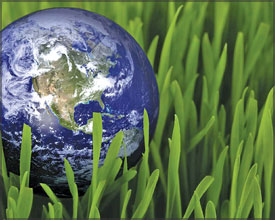Businesses are now entering the Green Economy...
Levasana Douglas Dept. of Management, Eastern University.
Green economics is the economics of the real world-the world of work,
human needs, the Earth’s materials, and how they mesh together most
harmoniously.
It is primarily about “use value”, not “exchange value” or money. It
is about quality, not quantity, for the sake of it. It is about
regeneration of individuals, communities, and ecosystems not about
accumulation of either money or material.
|

Green economics emphasizes creation of positive alternatives in
all areas of life. |
The industrial or capitalist definition of wealth has always been
about the accumulation of money and matter. Any use values generated
(i.e. social needs met) have been secondary a side-effect, by-product,
spin-off, or trickle-down to the primary goal of monetary accumulation.
For two centuries, the quest to accumulate money or capital drove a
powerful industrialization process that actually did spin off many human
benefits, however unfairly distributed. But blind material and monetary
growth has reached a threshold where it is generating more destruction
than real wealth.
A post-industrial world requires an economics of quality, where both
money and matter are returned to a status of means to an end. Green
economics means a direct focus on meeting human and environmental needs.
Tinkering with money, interest rates, or even state regulation is
insufficient in creating sensible economies. One can scarcely imagine a
more inefficient, irrational and wasteful way to organize any sector of
the economy than what we actually have right now.
Both the form and the content of sustainable agriculture, of green
manufacturing of soft energy, etc., are diametrically opposed to their
current industrial counterparts, which are intrinsically wasteful.
There is no justifiable rationale to be producing vast quantities of
toxic materials, or generating more deskilled than skilled labour, or
displacing labour rather than resources from production, or extending
giant wasteful loops of production and consumption through
globalization.
These are economic inefficiencies and economic irrationalities that
can only be righted by starting from scratch to look at the most elegant
and efficient ways of doing everything. As green economist Paul Hawken
writes, our social and environmental crises are not problems of
management, but of design. We need a system overhaul.
Green economics is not just about the environment. Certainly we must
move to harmonize with natural systems, to make our economies flow
benignly like sailboats in the wind of ecosystem processes. But doing
this requires great human creativity, tremendous knowledge, and the
widespread participation of everyone.
Human beings and human workers can no longer serve as cogs in the
machine of accumulation, be it capitalistic or socialistic. Ecological
development requires an unleashing of human development and an extension
of democracy. Social and ecological transformation goes hand in hand.
Green economics and green politics both emphasize the creation of
positive alternatives in all areas of life and every sector of the
economy.
Green economics does not prioritize support for either the “public”
or the “private” sector. It argues that both sectors must be transformed
so that markets express social and ecological values, and the state
becomes merged with grass roots networks of community innovation.
For this to happen, new economic processes must be designed and new
rules of the game written, so that incentives for ecological conduct are
built into everyday economic life.
The state can then function less as a policeman and more as a
coordinator.
This is a very different kind of “self-regulation” than current
profit- and power-driven market forces.
The basis for self-regulation in a green economy would be community
and intelligent design, which provides incentives for the right things.
Ten principles of a Green Economy:
*The Primacy of Use Value,
Intrinsic Value, and Quality:
This is the fundamental principle of the green economy as a service
economy, focused on end-use, or human and environmental needs. Matter is
a means to the end of satisfying real need, and can be radically
conserved.
Money similarly must be returned to a status as a means to facilitate
regenerative exchanges, rather than an end in itself. When this is done
in even a significant portion of the economy, it can undercut the
totalitarian power of money in the entire economy.
*Following Natural Flows:
The economy moves like a proverbial sailboat in the wind of natural
processes by flowing not only with solar, renewable, and “negawatt”
energy, but also with natural hydrological cycles, with regional
vegetation and food webs, and with local materials.
As society becomes more ecological, political and economic boundaries
tend to coincide with ecosystem boundaries. That is, it becomes
bioregional.
*Waste Equals Food:
In nature there is no waste, as every process output is an input for
some other process.
This principle implies not only a high degree of organizational
complementarities, but also that outputs and by-products are nutritious
and non-toxic enough to be food for something.
*Elegance and Multifunctionality:
Complex food webs are implied by the previous principle integrated
relationships which are antithetical to industrial society’s
segmentation and fragmentation.
What Roberts and Brandum (1995) call “economics with peripheral
vision,” this elegance features “problem-solving strategies that develop
multiple wins and positive side-effects from any one set of actions.”
*Appropriate Scale/Linked Scale:
This does not simply mean “small is beautiful,” but that every
regenerative activity has its most appropriate scale of operation. Even
the smallest activities have larger impacts, however, and truly
ecological activity “integrates design across multiple scales,”
reflecting influence of larger on smaller and smaller on larger.
To be continued |



